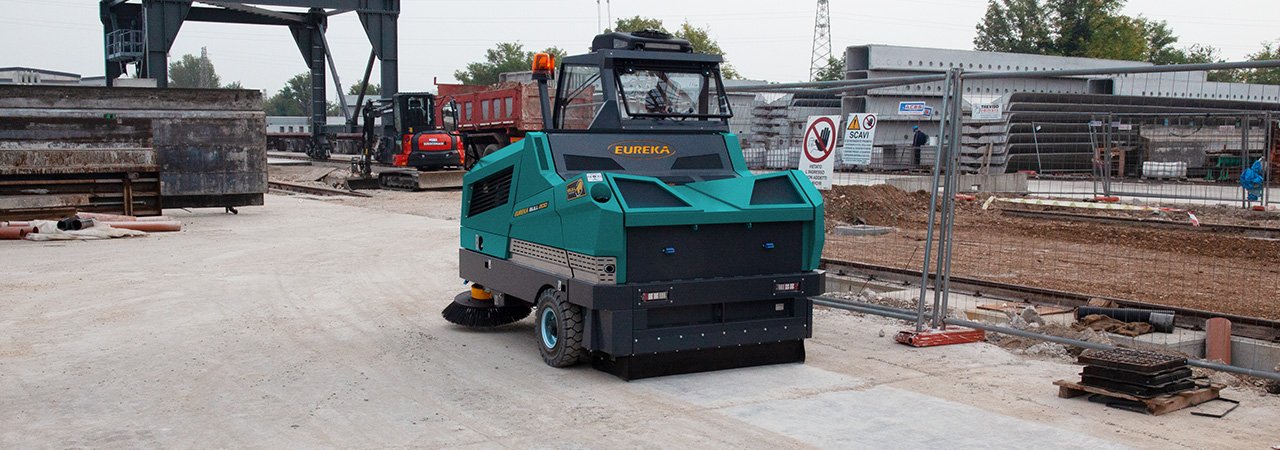Construction site cleaning - how, when and why?
The construction industry is one of the major stimuluses for those who design and manufacture professional floor cleaning equipment.
Sand, cement, dust, solidified plaster, earth, nails, sawdust, metal offcuts, and surplus materials from electrical and plumbing work such as wires and tubes are examples of just some of the items left behind after the builders go home. The dust and debris which are created during construction work and settle on the floor are particularly difficult to manage because these deposits vary in form, weight, and quantity.
Whether we’re talking about buildings under construction or properties undergoing restoration and modernisation, in the various phases of constructing a building such as a house, an apartment building or a warehouse, the site is always an interesting test area for a manufacturer of sweepers and floor cleaning machines.
In addition, construction companies have many reasons to carry out regular cleaning on the site, this generates an ever-increasing demand for high performance machines that offer the right features in these applications.
Four reasons for using industrial sweepers to clean construction sites:
- In the first place, having a floor cleaning machine on site is a matter of health. Construction waste, or more precisely the dirt from “demolition and reconstruction” as defined in the DPR 380/01 regulation, usually contains solid particles of mixed dimensions, which are generated when mechanically grinding materials. These particles can potentially contain artificial mineral fibres, fine wood dust, silica, cement, bitumen, tar, and other products such as glues and adhesives. Site workers are therefore at risk of inhaling this dangerous mix of particles which can lead to serious respiratory illness. Wearing the correct personal safety equipment and maintaining a clean environment are therefore important factors of both prevention and health.
- Effective cleaning tools furthermore save valuable time, this translates into economic savings. When cleaning needs to be carried out between one work phase and the next, the right machine can support a fluid transition between phases and therefore help maintain strict timelines. For example, laying a floor can’t be carried out unless the surface is completely free from debris and dust.
- If construction follows a demolition reducing and removing the vast quantities of dust generated is all the more urgent and can be particularly challenging.
- Accurately cleaning a site at the end of the project is important in making a good impression to potential buyers. It also makes it easier and faster to install the equipment or furnishings required for the buildings destined use for example productions lines, offices, or warehouse storage.
What features make a floor sweeper effective in construction site cleaning?
To keep an application as complex as a building site dust free, it is necessary to use professional floor cleaning equipment. As most cleaning operations will be carried out in an internal environment, emission free battery powered sweepers are generally more suitable.
Effective side brushes are also essential to collect the dirt which accumulates in corners, but it’s the robustness of the sweeper and the quality of its filtration system that really identify a floor cleaning machine that is adapted to these environments.
A powerful vacuum ensures that even fine dust is vacuumed, and not just lifted and dispersed into the air as the sweeper passes, which is what happens when using a dustpan and broom. However, without an effective filtration system, even the power of the vacuum motor wouldn’t be sufficient to control the dust. In fact, the filter is the biggest factor which divides different brands and models of sweepers and therefore needs to be chosen carefully according to the application and the requirements of the user. On a construction site, but also for domestic and industrial use, it is essential that the filter of a sweeper is made of quality material and that it is the right size to trap dust particles of varying dimensions whilst guaranteeing a constant and correct air flow.
The dust particles raised by the sweeper, particularly fine particles, must end up in the machine’s debris hopper rather than being newly dispersed into the environment. A professional filter such as Eureka’s Multipocket® filter, does exactly this: controlling dust, without getting blocked.





